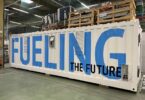There is no doubt about it: Sustainability is in fashion. This week Zara launched a limited line of black dresses, in different styles, made from carbon emissions, with the help of LanzaTech, a U.S.-based scale-up creating a circular economy system that turns pollution from steel mills and other greenhouse gases into textiles, household cleaners, laundry detergent, sustainable aviation fuel, perfume and more.
Other large corporates working with LanzaTech include Migros, L’Oreal, Total, British Airways, Shell, Unilever, Coty and ArcelorMittal. It is the sign of the times. Under pressure to cut their carbon footprint, large companies are increasingly partnering with startups and scale-ups to meet sustainability goals. That trend is likely to become even more prevalent in 2022.
By recycling carbon from industrial off-gases; syngas generated from biomass resources such as municipal solid waste, organic industrial waste or agricultural waste; and reformed biogas, LanzaTech, a member of the World Economic Forum’s Global Innovators community, says it can displace 30% of crude oil used today and reduce global CO2 emissions by as much as 10%. On April 28th the company filed its 1000th patent. Each of the patents contributes to a platform which enables the use of gas feedstocks for the production of a large variety of sustainable fuels, chemicals, and products, with an eye to covering use of the feedstocks of the future.
Recycled carbon is a key form of renewable carbon and is essential to eliminating the use of fossil fuels. A report published by the Nova Institute and Unilever in April estimates that demand for fossil-derived chemicals will more than double by 2050. Renewable carbon production will need to increase by a factor of 15 by 2050 to phase-out the use of fossil carbon in consumer products.
In the case of the Zara dresses, carbon emissions captured by LanzaTech were turned into ethanol and then transformed into polyester thread used to create nylon. To make polyester fabric you need Monoethylene Glycol (MEG) and Purified Terephthalic Acid (PTA). LanzaTech makes MEG from ethanol (converting to ethylene oxide and then MEG) which is then fused with PTA makes polyester. Today PTA comes from fossil inputs, but 100% of the MEG comes from recycled carbon. The final PET contains 20% MEG made from recycled carbon emissions and 80% PTA, so the garment has polyester made of 20% industrial carbon emissions.
The dresses, which are available on Zara.com, are the first items of clothing made from carbon waste to come to market using LanzaTech’s technology. Earlier this year, LanzaTech announced a collaboration with lululemon, an athletic apparel company, to create yarn and fabric using recycled carbon emissions. It also has a partnership with On to turn carbon emissions into ethylene vinyl acetate (EVA) foam, a material that can be used to engineer high-performance cushioning for running shoes.
The fashion industry is responsible for four to ten percent of global emissions and is the second biggest industry consumer of water but LanzaTech’s innovations go well beyond apparel and footwear. On December 9 steelmaker ArcelorMittal announced it had made a $30 million investment in LanzaTech. The steelmaker’s relationship with LanzaTech began in 2015 when the company first announced plans to utilize LanzaTech’s carbon capture and re-use technology at its plant in Ghent, Belgium. The €180 million Carbalyst plant – ArcelorMittal’s flagship carbon capture and re-use technology project – is currently under construction, with commissioning expected before the end of 2022.
Using LanzaTech’s gas fermentation technology, which captures carbon-rich waste gases from the steel making process and converts them into sustainable fuels and chemicals, the plant is expected to reduce ArcelorMittal Ghent’s CO2 emissions by 125,000 tons a year. It will also produce 80 million liters of bio-ethanol annually, which can be blended with traditional gasoline and used as a low-carbon alternative fuel for the transport sector.
LanzaTech’s technology is already touching many other industries. LanzaJet, a subsidiary of LanzaTech launched in 2020, is building a commercial scale plant in the U.S. state of Georgia to produce sustainable aviation fuel (SAF), attracting investments from Shell and British Airways. The plant will convert sustainable ethanol (a chemical compound widely blended with petrol to reduce its carbon intensity) into sustainable aviation fuel using a patented chemical process. Fuel produced at the plant promises to deliver a reduction of more than 70% in greenhouse gas emissions compared to conventional fossil jet fuel, the equivalent to taking almost 27,000 petrol or diesel cars off the road each year.
Meanwhile, earlier this year L’Oréal produced the first cosmetics bottle made from industrial emission; the result of a collaboration between the French cosmetics giant, LanzaTech, and energy company TotalEnergies that began in 2016. Coty, a multinational beauty care company, is turning to LanzaTech as a new source of ethanol for its fragrances. LanzaTech is also partnering with Unilever and green chemical maker India Glycols to produce a surfactant made from industrial carbon emissions instead of from fossil fuels. The shift in production uses biotechnologies and a newly configured supply chain between the three partners, who are working together for the first time. LanzaTech captures waste emissions and turns them into ethanol; India Glycols takes that ethanol and turn it into ethylene oxide, a feedstock to make surfactants. which Unilever then uses in a laundry detergent called OMO.
IN OTHER NEWS THIS WEEK:
CYBERSECURITY
Hackers Launch More Than 1.4 Million Attacks Through I4J Flaw
Hackers, including some linked with the governments of China, Iran, North Korea and Turkey, have launched more than 1.2 million attacks on companies globally since last Friday through a previously unnoticed vulnerability in a widely used piece of open-source software called Log4J. Cyber security group Check Point said the attacks relating to the vulnerability are accelerating, and that at some points its researchers were seeing more than 100 attacks a minute. The flaw in Log4J allows attackers to easily gain remote control over computers running apps in Java, a popular programming language.
Jen Easterly, director of the US Cybersecurity and Infrastructure Security Agency, or CISA, told industry executives that the vulnerability was “one of the most serious I’ve seen in my entire career, if not the most serious”, according to US media reports. Hundreds of millions of devices are likely to be affected, she said. IT security company Check Point said that in many cases, the hackers were taking control of computers to use them to mine cryptocurrency, or to become part of botnets, vast networks of computers that can be used to overwhelm websites with traffic, to send spam, or for other illegal purposes. Both CISA and the UK’s National Cyber Security Centre have now issued alerts urging organizations to make upgrades related to the Log4J vulnerability, as experts attempt to assess the fallout.
Cybersecurity researchers say I4J is one of the most dire cybersecurity threats to emerge in years and could enable devastating attacks, including ransomware, in both the immediate and distant future. Government-sponsored hackers are often among the best-resourced and most capable, analysts say.“The effects of this vulnerability will reverberate for months to come—maybe even years—as we try to close these doors and try to hunt down all the actors who made their way in,” John Hultquist, vice president of intelligence analysis at the U.S.-based cybersecurity firm Mandiant told the Wall Street Journal.
RETAIL
Balenciaga To Launch Metaverse Business Unit
Balenciaga is creating a dedicated business unit to explore opportunities for marketing and commerce in the metaverse, CEO Cédric Charbit said, speaking at at a Business Of Fashion gathering. Virtual fashion has become a focus for Balenciaga, which released its Fall 2021 collection via a video game and collaborated with gaming platform Fortnite on a collection of digital skins for players. In creating a dedicated team to work on projects in the metaverse, Balenciaga joins brands Gucci (which recently staged a virtual-reality fashion exhibition on Roblox and created a metaverse pop-up activation on The Sims) and OTB, the Diesel and Margiela parent, which this week announced a new business unit called Brave Virtual Xperience.
TRANSPORTATION
Ride Share Spending To Exceed $937 Billion By 2026
A new study by Juniper Research has found that ride sharing spending by consumers globally will exceed $937 billion by 2026, comparable to 50 times the combined annual revenue of Transport for London, New York City’s MTA, and the Beijing Metro in 2021. This spend represents an increase from $147 billion in 2021 and total growth of 537% over the next 5 years. The concept of ride sharing involves users accessing single-occupancy and shared carpool-style services provided by private drivers operating their own vehicles; coordinated by platforms such as Lyft and Uber.The research identified consumers in the U.S. and China as leading global spend on ride sharing services; accounting for 65% of market value in 2026. It highlighted future government initiatives to reduce private vehicle usage in cities, allied with a strong pandemic recovery, as key to these countries’ positions as leaders.
Toyota To Spend $35 Billion On EV Push In Effort To Take On Tesla
Toyota said it will pour $35 billion into a shift towards electric vehicles as the world’s biggest carmaker sets itself up for direct rivalry with Tesla and joins other groups in a push for carbon neutrality. It marks a major increase in its electric targets as it aims to sell 3.5 million battery-powered vehicles annually by 2030, with the launch of 30 EV models by then in a line-up including sports cars and commercial vehicles. The company has in the past argued that a longer-term fix for global warming should be a mix of hybrids, EVs and hydrogen-powered vehicles instead of a single bet on battery-powered cars.
ENERGY
ENGIE AND Eqinor Launch Project To Develop Low-Carbon Hydrogen
Engie and Equinor have announced the H2BE project aiming to develop low-carbon hydrogen production from natural gas in Belgium.The H2BE project is built upon the previously announced MoU between the companies, signed in February for jointly developing low carbon hydrogen projects. The H2BE project aims at producing hydrogen from natural gas using autothermal reforming (ATR) technology combined with carbon capture and storage.The ATR technology has an over 95% decarbonisation rate. The captured CO2 will be transported in liquid form and permanently and stored at a site in the sub-surface of the Norwegian North Sea.
ARTIFICIAL INTELLIGENCE
DeepMind Debuts Massive Language AI That Approaches Human-Level Reading Comprehension
DeepMind, the London-based A.I. research company that is owned by Google-parent Alphabet, has created an artificial intelligence algorithm that can perform a wide range of language tasks—from reading comprehension to answering questions on a broad range of subjects—better than any existing similar software. In a few areas, such as a high school reading comprehension test, the software approaches human-level performance. But in others, including common sense reasoning and mathematical reasoning, the system fell well short of human abilities.In announcing the new language model , DeepMind signaled its intent to play a larger role in advancing natural language processing (NLP). The company is best known for creating an AI system that could beat the world’s top human player in the strategy game Go, a major milestone in computer science, and it recently achieved a breakthrough in using AI to predict the structure of proteins. But DeepMind has done far less work on NLP than rival labs, such as OpenAI, the San Francisco-based AI research company, and the AI research arms of Facebook, Microsoft, Alibaba, Baidu, and even its sister company Google.
AUTOMATION
Tyson Foods Ramps Up Meat Plant Automation Plans
Tyson Foods said it plans to spend about $1.3 billion to automate parts of its production lines over the next three years, as meatpackers struggle with a nationwide labor shortage in the U.S. that has left many processing plants understaffed this past year.The Arkansas-based meat giant said December 16 that it it plans to invest more than $500 million in its 2022 fiscal year alone on automating some of the most labor-intensive parts of its business, including de-boning chicken products.
To access more of The Innovator’s News in Context articles click here.






